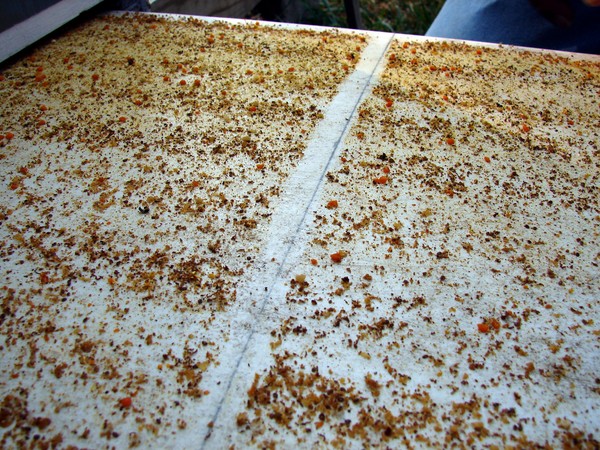Submitted by J. Morgan
There's a lot of information that can be gained by taking a closer look at something we usually disregard. Particularly, the boards on the bottom of our bee hive. At the present time, I have screened bottom boards under my hives... so what am I talking about?
Today, I paid another visit to Jim and Cindy's apiary for a hands-on look at some of the fodder that falls to the bottom of the hive. Call it a lunch date with a bee, a mite, and a wax moth if you will. At first glance, the bottom board looks quite disgusting. Just look at all those crunchies on it. After a closer second look, I'm thinking about the crust I put on top of my zucchini casserole. Mmmmm.
But really, there's more to be gained here than the next recipe idea. We're talking about determining if and when we should take action against the parasites that inhabit our hives. Varroa mites, in small numbers, may not be reason enough for concern, but if we noticed a climb in these numbers, what would we do? How many are too many? Are we really looking anyway?
At SIBA, our most experienced beekeepers feel the alcohol wash is the defacto standard on monitoring mites. Yes, it kills some bees, but the sampling method is easy, repeatable, and the results are instant and reliable. It's our belief that killing a sample of bees now is better than the colony dying a slow death from deformed wing virus, or other diseases vectored by mites. If you are someone who doesn't like that sound of killing a bee sample, then maybe using a sticky board is for you. Just understand that there is a certain art to using a sticky board. You must be consistent in your use. For example, a 24-hour mite drop is a standard length of time to collect and then count the mites on your board. This entails putting a clean board under your hive or screened bottom. It's usually coated with an oil, or cooking spray so when the mites fall, they stick and can't walk off the board. You should diligently come back after 24 hours or so and count the mites on the board. Clean the board off, and do it again. You need to form a base number of mites and decide how many mites over a 24-hour drop are enough to move you to treat.
Consider this though, what if you came back to the hive after 24-hour and found 35 mites on your sticky board? 35 mites under a 2 deep colony may not be as bad as 35 mites under a single deep colony. As your brood volume increases, then the number of mites will too. So, your base number is affected by the size of the colony, the time of the season, perhaps other variables in the course of the season. Good logs will help you form a more accurate basis for your colonies in your area.
Here's how Jim and Cindy do it. Take a look at this image. Jim has drawn a line across the width of his board and he and Cindy count the mites on one half of the board. Read below as Cindy describes how they interpret their results and when they will take action.
"We will count 100 mites over a one day drop on an average-sized two-story beehive. When we have a really huge hive, that number might be bigger. When we have a small, one-story hive, it's lower. The last couple of years, I've been doing a 2-3 day drop count and dividing to get a daily average. I think this gives you a truer count. You also want the count to be over a period of time when you are not in there thrashing around and stirring things up. We usually scrape the sticky boards after we are done in the apiary, then 2-3 days later, I go out, count and get my average daily drop."
Rusty over at the Honeybee Suite also explains the use of sticky board in a clear and meaningful manner. Be sure to take a look here. She's an awesome beekeeper.
How we take action against mites is determined by our beliefs on what should and shouldn't go into a beehive. Many of our members employ more natural approaches. Some may be strict about this, while others may actually submit to chemicals. We are not here to judge. We only want to keep you diligent in monitoring for mites and taking action early before they make your bees sick. Let's talk more about it on the Morgan Ranch, or leave a comment below!



